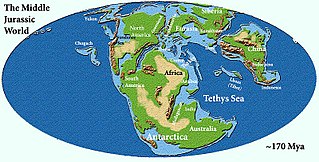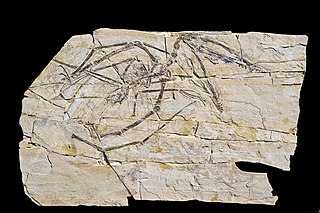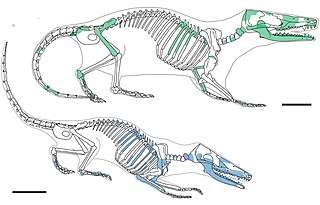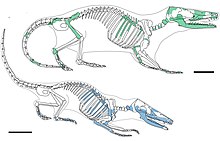
The Middle Jurassic is the second epoch of the Jurassic Period. It lasted from about 174.1 to 161.5 million years ago. Fossils of land-dwelling animals, such as dinosaurs, from the Middle Jurassic are relatively rare, but geological formations containing land animal fossils include the Forest Marble Formation in England, the Kilmaluag Formation in Scotland, the Calcaire de Caen of France, the Daohugou Beds in China, the Itat Formation in Russia, the Tiouraren Formation of Niger, and the Isalo III Formation of western Madagascar.

Karaurus is an extinct genus of stem-group salamander (Caudata) from the Middle to Late Jurassic (Callovian–Kimmeridgian) Karabastau Formation of Kazakhstan. It is one of the oldest salamanders known.

Goniopholididae is an extinct family of moderate-sized semi-aquatic neosuchian crocodyliformes. Their bodyplan and morphology are convergent on living crocodilians. They lived across Laurasia between the Middle Jurassic and the Late Cretaceous.

Amphitheriidae is a family of Mesozoic mammals restricted to the Middle Jurassic of Britain, with indeterminate members also possibly known from the equivalently aged Itat Formation in Siberia and the Anoual Formation of Morocco. They were members of Cladotheria, more derived than members of Dryolestida, and forming a close relationship with Peramuridae. Amphitheriidae is the only family of the order Amphitheriida.
Eileanchelys is an extinct genus of primitive turtle from the Middle Jurassic (Bathonian) period some 164 million years ago of Britain. Only one species is recorded, Eileanchelys waldmani. It is the best-represented turtle from the Middle Jurassic, because of the amount of specimens that can be assigned to it. The turtle is also one of the oldest turtles ever found to be aquatic, and might represent a milestone in turtle evolution.

Anoualerpeton is an extinct genus of lissamphibian in the family Albanerpetontidae. It is the oldest and most primitive albanerpetontid known. Fossils have been found of two different species, Anoualerpeton priscus from the Middle Jurassic (Bathonian) aged Forest Marble and Kilmaluag formations of England and Scotland, and Anoualerpeton unicus from Late Jurassic-Early Cretaceous (Tithonian-Berriasian) Ksar Metlili Formation of Morocco. A. unicus is the only named albanerpetontid from Gondwana.

Marmorerpeton is an extinct genus of prehistoric stem group-salamanders that lived in Britain during the Bathonian stage of the Middle Jurassic. They are among the oldest known salamanders. Two species were named when the genus was first described by Susan E. Evans et al. in 1988, M. freemani, and M. kermacki, from fragmentary remains found via screenwashing in the Forest Marble Formation of England. Due to the size of their osteocytic lacunae suggesting a large genome size and some morphological characters, like the presence of calcified cartilage in the medulla of its humerus, it was assumed that Marmorerpeton was neotenic. New more complete remains of a new species M. wakei were described in 2022 from the Kilmaluag Formation of the Isle of Skye, Scotland. These conclusively demonstrated that Marmorerpeton was neotenic, and was a member of the family Karauridae, with the other two members of the family, Karaurus and Kokartus being known from the Middle-Late Jurassic of Central Asia. The teeth appear to have been weakly pedicellate.

Monofenestrata is an unranked group of pterosaurs that includes the family Wukongopteridae and the suborder Pterodactyloidea.

The Karauridae are a family of stem-group salamanders (Caudata) that are known from the Middle Jurassic to Early Cretaceous in Central Asia, Northern Asia and Western Europe. The family includes four members: Karaurus from the Middle-Late Jurassic Karabastau Formation of Kazakhstan, Kokartus from the Middle Jurassic Balabansai Formation of Kyrgyzstan, Marmorerpeton from the Middle Jurassic Forest Marble Formation of England and Kilmaluag Formation of Scotland, and Kuzbassia from the Early Cretaceous (Aptian) Ilek Formation. The members are some of the oldest known salamanders. The family is united by several morphological characters, including sculptured skull roof bones. Like some modern salamanders, karaurids were neotenic. Members of the family likely fed via suction feeding on small fish and invertebrates. The Early Cretaceous Siberian Kulgeriherpeton has been suggested to be a karaurid by some authors.

Marmoretta is an extinct genus of small lepidosauromorph reptile known from the Middle Jurassic (Bathonian) of Britain, as well as the Late Jurassic of Portugal. It contains a single species, Marmoretta oxoniensis.

Stereognathus is an extinct genus of tritylodontid cynodonts from the Middle Jurassic of the United Kingdom. There is a single named species: S. ooliticus, named after the Great Oolite deposits of England. A second species, S. hebridicus, was named after the Hebrides in Scotland, where it was found; it was synonymized with S. ooliticus in 2017.

The Duntulm Formation is a sedimentary geologic formation deposited in the Inner Hebrides, Scotland. The formation was previously known as the 'Lower Ostrea Beds', and dates to the Bathonian stage of the Middle Jurassic. The formation is noted for its highly fossiliferous oyster beds, which compose of the species Praeexogyra hebridica. The sedimentary sequence also forms part of the Great Estuarine Group.

Allkaruen is a genus of "rhamphorhynchoid" pterosaur from the Early Jurassic Cañadon Asfalto Formation in Argentina. It contains a single species, Allkaruen koi.

Borealestes is a genus of docodontan from the Middle Jurassic of Britain, first discovered on the Isle of Skye near the village of Elgol. It was the earliest mammaliaform from the Mesozoic found and named in Scotland. A second species and was later found in other Middle Jurassic sites in England, but is now shown to be a different genus. A new species, B. cuillinensis was named in 2021, also from Skye.
Wareolestes rex is a mammaliaform from the Middle Jurassic (Bathonian) rocks of England and Scotland. It was originally known from isolated teeth from England, before a more complete jaw with teeth was found in the Kilmaluag Formation of Skye, Scotland.

Palaeoxonodon is an extinct genus of cladotherian mammal from the Middle Jurassic of England and Scotland.
Dobunnodon its an extinct genus of docodont from the Middle Jurassic (Bathonian) Forest Marble Formation of England, first discovered in Oxfordshire near the village of Kirtlington. The type species, D. mussettae, was originally named as a species of Borealestes in 2003.
Michael Waldman is a British palaeontologist known for his work on fossil fish, mammals, and reptiles. He also discovered the globally important fossil site of Cladach a'Ghlinne, near Elgol on the Isle of Skye, Scotland. This site exposes the Kilmaluag Formation and provides a valuable record of Middle Jurassic ecosystems. During the 1970s he visited the site several times with fellow palaeontologist Robert Savage. The fossil turtle Eileanchelys waldmani was named after Michael in recognition of his notable contribution to palaeontology.

Bellairsia is an extinct genus of stem-squamate known from a single species, Bellairsia gracilis, from the Middle Jurassic (Bathonian) of England and Scotland. It is amongst the oldest squamates known. It was originally described in 1998 by Susan E. Evans from disarticulated individual bones, including the holotype dentary, collected from the Forest Marble Formation in Kirtlington Quarry, Oxfordshire, England. It was named in honor of British herpetologist and vertebrate anatomist Angus Bellairs. In 2022, a partial 70% complete skeleton was described from the equivalently aged Kilmaluag Formation of the Isle of Skye, Scotland. The partial skeleton had an estimated snout-vent length of around 6–7 centimetres (2.4–2.8 in). While originally considered a member of Scincomorpha, the 2022 study recovered it to be a stem-group squamate, with the phylogeny recovering it as part of a weakly supported clade also containing Huehuecuetzpalli and Oculudentavis.
Ceoptera is an extinct genus of darwinopteran pterosaur from the Middle Jurassic Kilmaluag Formation of Scotland. The genus contains a single species, C. evansae, known from a partial skeleton.It is the only pterosaur from Kilmaluag Formation. Ceoptera represents the second pterosaur named from Scotland, after Dearc in 2022.





















